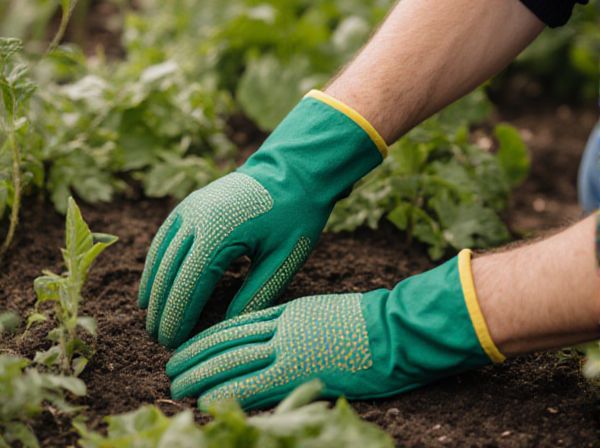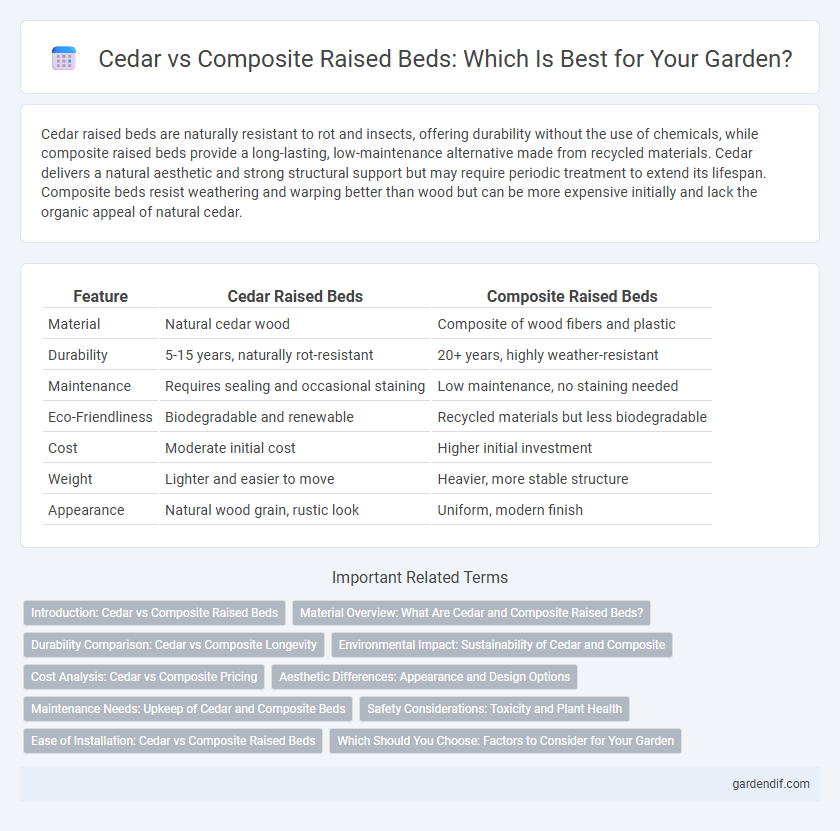
Cedar vs Composite raised beds Illustration
Cedar raised beds are naturally resistant to rot and insects, offering durability without the use of chemicals, while composite raised beds provide a long-lasting, low-maintenance alternative made from recycled materials. Cedar delivers a natural aesthetic and strong structural support but may require periodic treatment to extend its lifespan. Composite beds resist weathering and warping better than wood but can be more expensive initially and lack the organic appeal of natural cedar.
Table of Comparison
| Feature | Cedar Raised Beds | Composite Raised Beds |
|---|---|---|
| Material | Natural cedar wood | Composite of wood fibers and plastic |
| Durability | 5-15 years, naturally rot-resistant | 20+ years, highly weather-resistant |
| Maintenance | Requires sealing and occasional staining | Low maintenance, no staining needed |
| Eco-Friendliness | Biodegradable and renewable | Recycled materials but less biodegradable |
| Cost | Moderate initial cost | Higher initial investment |
| Weight | Lighter and easier to move | Heavier, more stable structure |
| Appearance | Natural wood grain, rustic look | Uniform, modern finish |
Introduction: Cedar vs Composite Raised Beds
Cedar raised beds offer natural resistance to rot and insects, providing durability without the need for chemical treatments. Composite raised beds combine recycled materials and plastics, delivering long-lasting strength and low maintenance with a modern aesthetic. Both options cater to gardeners seeking sustainable and resilient planting solutions for various outdoor environments.
Material Overview: What Are Cedar and Composite Raised Beds?
Cedar raised beds are made from natural cedar wood, known for its durability, resistance to rot, and natural insect-repelling properties, making it an eco-friendly and long-lasting choice for garden structures. Composite raised beds are constructed from a blend of recycled wood fibers and plastic resin, offering high resistance to moisture, decay, and warping, which ensures low maintenance and extended lifespan. Both materials provide sturdy options, but cedar emphasizes natural sustainability while composite emphasizes durability and weather resistance.
Durability Comparison: Cedar vs Composite Longevity
Cedar raised beds offer natural resistance to rot and insects, typically lasting 10 to 15 years without chemical treatment, making them a durable choice for garden frameworks. Composite raised beds, made from recycled wood fibers and plastic, can extend longevity up to 25 to 30 years due to their resistance against moisture, warping, and decay. Both materials provide strong durability, but composites generally outperform cedar in long-term endurance under varied weather conditions.
Environmental Impact: Sustainability of Cedar and Composite
Cedar raised beds offer natural durability without chemical treatments, making them a sustainable option due to their biodegradability and renewable sourcing from managed forests. Composite raised beds, composed of recycled plastics and wood fibers, reduce landfill waste and require less maintenance, yet their non-biodegradable components can impact long-term soil health. Choosing cedar supports ecosystem balance with lower carbon emissions during production, whereas composite beds emphasize resource recycling but may contribute to microplastic accumulation.
Cost Analysis: Cedar vs Composite Pricing
Cedar raised beds typically cost between $15 and $25 per linear foot, offering natural resistance to rot and insects without chemical treatments, making them a durable yet higher upfront investment. Composite raised beds range from $20 to $35 per linear foot, with a higher initial price justified by their longevity, low maintenance, and resistance to weather, fading, and pests. Considering long-term value, composite materials often reduce replacement and upkeep costs compared to cedar, which may need more frequent repairs or sealing.
Aesthetic Differences: Appearance and Design Options
Cedar raised beds offer a natural, warm aesthetic with rich reddish tones and a grain pattern that enhances outdoor garden spaces, appealing to those who prefer a rustic, organic look. Composite raised beds provide a sleek, uniform appearance with customizable color options and modern design features, making them ideal for contemporary garden styles. The choice between cedar and composite materials significantly impacts the visual harmony and overall design flexibility of raised garden beds.
Maintenance Needs: Upkeep of Cedar and Composite Beds
Cedar raised beds require regular maintenance such as sealing or staining every few years to preserve their natural resistance to rot and insects. Composite raised beds, made from a blend of wood fibers and recycled plastics, offer low-maintenance benefits, as they do not need sealing or painting and resist weathering and decay more effectively. While cedar provides a more natural aesthetic, composite materials minimize upkeep efforts, making them ideal for gardeners seeking durability with minimal maintenance.
Safety Considerations: Toxicity and Plant Health
Cedar raised beds are naturally resistant to rot and insects without the need for chemical treatments, making them a safer option for growing edible plants due to their non-toxic properties. Composite raised beds, made from recycled wood fibers and plastic, do not leach harmful chemicals but may contain additives or binders that require verification to ensure they are food-safe. Prioritizing materials free from pesticides, preservatives, or harmful dyes in raised beds is essential to maintaining healthy soil and preventing contamination of vegetables and herbs.
Ease of Installation: Cedar vs Composite Raised Beds
Cedar raised beds offer natural lightweight properties and pre-cut options, making them easier to handle and assemble without specialized tools. Composite raised beds often come in interlocking panels that snap together, reducing installation time and eliminating the need for nails or screws. Both materials provide straightforward installation, but cedar's natural boards might require more precise alignment compared to the modular design of composite beds.
Which Should You Choose: Factors to Consider for Your Garden
Cedar raised beds offer natural rot resistance and chemical-free durability, making them ideal for organic gardening and long-term use, while composite raised beds provide enhanced longevity and low maintenance with weather-resistant materials that resist warping and insect damage. Consider your budget, desired lifespan, environmental impact, and aesthetic preferences when choosing between the warm, natural appeal of cedar and the modern, synthetic durability of composite materials. Location-specific climate conditions and personal gardening goals also influence whether cedar's biodegradability or composite's permanence best suits your garden's needs.
Cedar vs Composite raised beds Infographic

 gardendif.com
gardendif.com